Phrynos was a Greek potter, active in Athens, circa 560-545 BC. He is one of the Little masters. Three signed Lip cups by him are known:

Athens is the capital and largest city of Greece. Athens dominates the Attica region and is one of the world's oldest cities, with its recorded history spanning over 3,400 years and its earliest human presence starting somewhere between the 11th and 7th millennium BC.

The Little masters were a group of potters and vase painters who produced vases of the Attic black-figure style featuring well-done figures in miniature. They were active in Athens approximately 560 — 530 BC. They mainly produced Little-master cups: lip cups, band cups and droop cups, but were not entirely limited to such shapes. The group includes:
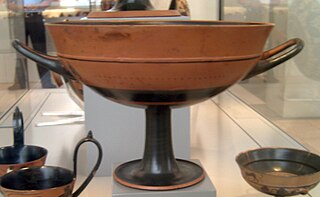
Lip cups are a type of ancient Greek Attic Little-master cups. Lip cups were produced from the middle of the sixth century BC in Athens. They resemble Gordion cups, but their lips or rims were more clearly distinguished from the rest of the body. They had high feet on broad bases. Early specimens in particular feature hollow conical feet with walls of even thickness.

The Museum of Fine Arts in Boston, Massachusetts, is the fifth largest museum in the United States. It contains more than 450,000 works of art, making it one of the most comprehensive collections in the Americas. With more than one million visitors a year, it is the 60th most-visited art museum in the world as of 2017.

The British Museum, in the Bloomsbury area of London, United Kingdom, is a public institution dedicated to human history, art and culture. Its permanent collection of some eight million works is among the largest and most comprehensive in existence, having been widely sourced during the era of the British Empire. It documents the story of human culture from its beginnings to the present. It was the first public national museum in the world.
The Wine Museum of Torgiano is a private museum, specialized and completely dedicated to the culture of wine.
Located in an area of wine production, the museum was founded by the wine producers Giorgio Lungarotti, owner and founder of Cantine Lungarotti Winery and his wife Maria Grazia Marchetti in 1974 and is run, together with the Olive and oil Museum, by the Lungarotti Foundation, which promotes studies, cultural events and exhibitions aimed at enhancing the wine and olive oil economy. Through its archaeological, ethnographic and arts collections, the museum provides information on the role of wine in western culture, where wine has always been highly valued not only for its energetic and strengthening properties but also as a cultural product.
The three vases all appear to have been painted by the same painter, the Phrynos Painter, to whom some further pieces can be ascribed. The potter Phrynos probably worked together with the potters Archikles and Glaukytes, as some of their vases bear close similarities.

The Phrynos Painter was an Attic black-figure vase painter, active in Athens between c. 560 and 545 BC. He was allocated the conventional name Phrynos Painter after the potter Phrynos, as he had painted three cups signed by the latter:
This page is based on this
Wikipedia article Text is available under the
CC BY-SA 4.0 license; additional terms may apply.
Images, videos and audio are available under their respective licenses.
Kleitias was an ancient Athenian vase painter of the black figure style who flourished c. 570–560 BCE. Kleitias' most celebrated work today is the François Vase, which bears over two hundred figures in its six friezes. Painted inscriptions on four pots and one ceramic stand name Kleitias as their painter and Ergotimos as their potter, showing the craftsmen's close collaboration. A variety of other fragments have been attributed to him on a stylistic basis.
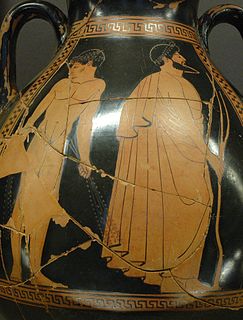
The Kleophrades Painter is the name given to the anonymous red-figure Athenian vase painter, who was active from approximately 510 – 470 BCE and whose work, considered amongst the finest of the red figure style, is identified by its stylistic traits.
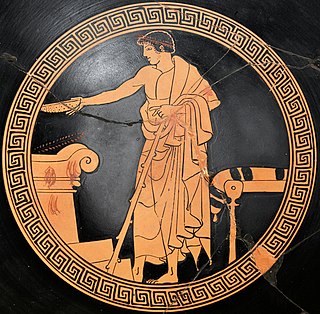
Makron was an ancient Greek vase painter active in Athens ca. 490–480 BC. Though only one signed example of his work is known to have survived, some 350 vases have been attributed to him by Sir John Beazley, making him one of the best surviving painters of the red-figure period.

Psiax was an Attic vase painter of the transitional period between the black-figure and red-figure styles. His works date to circa 525 to 505 BC and comprise about 60 surviving vases, two of which bear his signature. Initially he was allocated the name Menon Painter by John Beazley. Only later was it realised that the artist was identical with the painters signing as Psiax.

The Amasis Painter was an ancient Greek vase painter who worked in the black-figure technique. He owes his name to the signature of the potter Amasis, who signed 12 works painted by the same hand. At the time of the exhibition, "The Amasis Painter and His World" (1985), 132 vases had been attributed to this artist.

The Andokides Painter was an ancient Athenian vase painter, active from approximately 530 to 515 B.C. His work is unsigned and his true name unknown. He was identified as a unique artistic personality through stylistic traits found in common among several paintings. This corpus was then attributed by John D. Beazley to the Andokides Painter, a name derived from the potter Andokides, whose signature appears on several of the vases bearing the painter's work. He is often credited with being the originator of the red-figure vase painting technique. To be sure, he is certainly one of the earliest painters to work in the style. In total, fourteen amphorae and two cups are attributed to his hand. Six of the amphorae are "bilingual", meaning they display both red-figure and black-figure scenes.
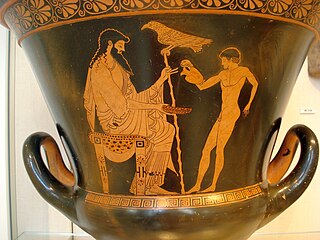
Eucharides Painter is the common nickname of an ancient Greek artist who decorated but did not sign attic vases. Neither his real name, nor the dates of his birth and death are known. Presumably this artist was a pupil of the Nikoxenos painter.

Tleson was an Attic potter and perhaps also a vase painter in the black-figure style.
He was the son of the famous potter Nearchos and brother of Ergoteles.
His workshop apparently produced mostly Little-master cups. Most of his vases were painted by the Tleson Painter, whose real name is unknown, and whose conventional name is derived from Tleson. Based on the fact that vases known by that hand so far are only ever signed by Tleson, John Beazley suggested that Tleson and the Tleson painter may be identical. There is no proof for this hypothesis. Some of Tleson’s pots were painted by other artists, such as Oltos and the Centaur Painter.
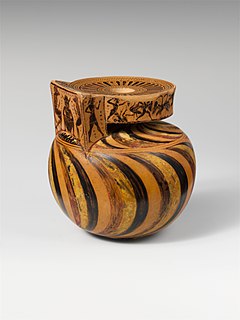
Nearchos was an Attic potter and vase painter of the black figure style, active in Athens c. 570 to 555 BC.

Little-master cups are a type of Attic black-figure cups, produced around the middle and third quarter of the sixth century BC. Their name is based on their fine small-format decoration.
Little-master cups are later in origin than Siana cups, but both types were produced over a considerable period of time. The Little masters painted only the small upper frieze above the carination of the cup, at times also the lip or handle areas. It is probably that only few of the painters of Siana cups also painted Little-master cups. One of the first artists to introduce the Little-master cup in Athens was Kleitias. The change in decoration went along with a lengthening of the cup foot. The dedicated painters of Little-master cups rarely painted larger formas, whereas painters primarily specialised in large vases are known to also have painted Little-master cups. Stylistic comparison between larger and smaller formats of the period remains difficult.
Sokles was an ancient Greek potter, active in the middle of the 6th century BC, in Athens.
The following signed Little-master cups or fragments thereof are known, all of them painted by the Sokles Painter:
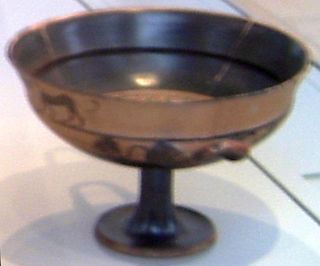
Ergoteles (Έργοτέλης) was a Greek potter, active in Athens around the middle of the 6th century BC. He was the son of the famous potter Nearchos and the brother of Tleson.
Three signed Little-master cups by him are known:

A Siana cup is a type of Attic cup decorated in the black-figure technique. They are named after one of their find locations, the necropolis of the ancient city of Siana on Rhodes. During the second quarter of the 6th century BC, Siana cups were the predominant cup shape in Athens. The shape remained popular later and was still being produced in large quantities during the era of the Little-master cups.

The Taleides Painter was an Attic vase painter of the black-figure style, active in the second half of the 6th century BC. His conventional name is derived from his close cooperation with the potter Taleides, many of whose vases he painted. He also worked for the potter Timagoras.
The Group of Rhodes 12264 is a Group of Attic black-figure vase painters, active in Athens around the middle of the 6th century BC. They belong to the so-called Little masters. The Group is named after the Droop cup inv. 12264 in the Archaeological Museum of Rhodes. They painted exclusively cups, mostly Droop cups with friezes in the handle zone.
The BMN Painter was an Attic vase painter in the black-figure style, active during the third quarter of the 6th century BC.
The Painter of the Vatican Mourner was an Attic black-figure vase painter, active in the middle of the sixth century BC and closely connected with the artists of the E Group. His real name is now known.
His name vase is in the Vatican Museum and depicts a mourning woman standing before the nude body of a dead man on a bed of straw. There is no consensus on the interpretation of the scene. Eos and Sarpedon have been suggested, as have Oinone and Paris. John Boardman describes him as a thoughtful but sometimes inprecise artist.

The Lysippides Painter was an Attic vase painter in the black-figure style. He was active around 530 to 510 BC. His real name is not known.



















